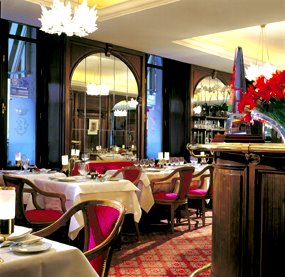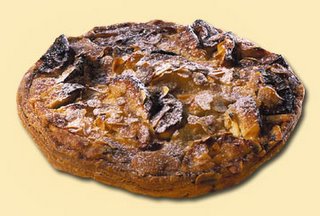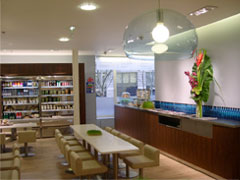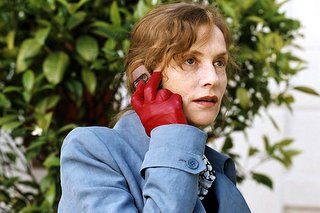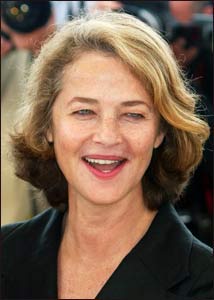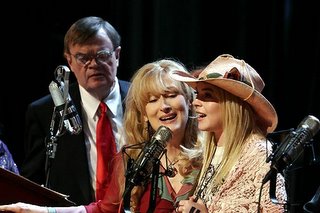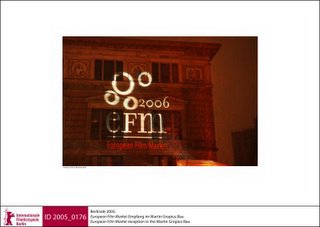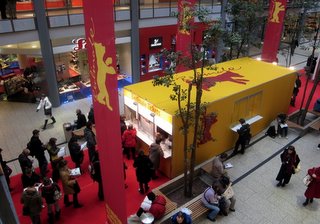





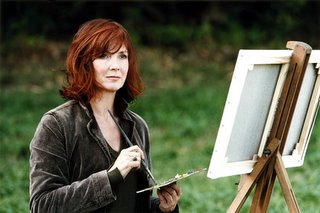












A long time ago (May 11-22, 2005) in a galaxy far, far away (Cannes, France) chaos has engulfed the Riviera. The sales of Palme d’Or-winning films to outlaying star studios are in dispute. Hoping to resolve the matter with a blockade of deadly cocktails, the greedy Hollywood studios have stopped sending all party invitations to the small independents. While the editors at the daily trade magazines endlessly debate this alarming chain of events, the Supreme Chancellor, Emir Kusturica, has secretly dispatched two juries, the guardians of peace and justice on the Croisette, to settle the conflict...
CANNES FILMS FESTIVAL: EPISODE 58
Ever since 1946, when Louis Lumière took on the duty of the festival’s inaugural jury president, the Cannes Film Festival has evoked images of red carpets, sunny beaches and glamour. For two weeks each May, international stars and film industry executives make their way to the French Riviera to celebrate “la septième art” with as much gratuitous luxury as possible. Cannes is the setting for two parallel plots intertwining, namely the Cannes festival and the Cannes film market. As famous directors and their beautiful muses stroll the red carpet outside of Le Palais, inside, the international film market is at its highest peak of activity as multi-million dollar distribution deals are made every minute. The Croisette becomes a veritable college campus where it’s all “work hard, play hard” as champagne flows like water and securing party invites becomes an extra-curricular activity. Colossal film posters and animations decorate the Croisette as film fans line up outside, cameras in hand, ready to snap their way to stardom … or Ebay. The Cannes Film Festival is so unique it is almost indescribable, but I am here to share the story of how I lost my Cannes Film Festival virginity on a sunny summer day just a few weeks ago…
Most of the activity in Cannes takes place at Le Palais du Festival, an enormous building right on La Croisette (the large strip separating the beaches from the major hotels that runs throughout the city). Outside, the red carpet is the scene of the premieres of the films “In Competition” and the inside is filled with “stands,” i.e. veritable offices for sales agencies, digital imaging and the film commissions of various companies. Each stand is decorated with film posters, big-screen televisions and often hors d’œuvres served to buyers during important business meetings. The stands are located both in the Riviera section of Le Palais and on the bottom level. Outside of the Riviera, the pavilions of the “International Village” line the beach as each country’s flag hangs proudly over its tent, usually the base of national film commissions offering a warm welcome to its inhabitants in town. The American Pavilion, for example, sponsored round table discussions between directors and stars such as David Cronenberg and Morgan Freeman and also provided free internet access for its members in addition to a selection of Americanized sandwiches and salads for lunch. Further down the Croisette is the Pantiero, the site of UniFrance, the Rendez-Vous des Exploitants (a huge modern space dedicated to partners of the festival such as Nestle who offered free ice cream ,and coffee) and the Plage des Palmes, a high-class restaurant right on the water reserved only for very important business executives discussing distribution deals over some foie gras in the sun. Other companies set up camp in the luxurious four and five-star hotels lining the Croisette such as The Majestic, The Hotel Martinez, The Noga Hilton and The Carlton. Just a few minutes in the lobby of any of these hotels ensures at least one celebrity sighting and makes even the poorest of interns (cough, cough) feel like a star for a brief moment in time.
Back in Le Palais, on the basement level, I joined the Cannes Market News team. The Cannes Market News is a free daily magazine in English dedicated entirely to the international film market and featuring the latest festival news, events and comprehensive screenings list for the following day. The CMN is a partnership between Le Film Français and the Marché du Film (the international film market, headed by Jérôme Paillard). As the sun shined over the Riviera, I spent most of my two weeks in Cannes in the basement of Le Palais. It was the most exciting time I have ever spent in a basement, or anywhere else for that matter. Le Film Français placed me in charge of handling the International Publicity in addition to all of the editorial coordination. I was responsible for contacting our clients, preparing their advertisements (making sure the formats of the ads were correct, which, though ostensibly a facile task, was oftentimes ingratiating labor when a client was unreachable and an ad was not in the correct format), coordinating the daily articles with Screenmedia, the agency that provided us editorial content, planning the photos for the photos page with our photographer and going with him every day to write down the info for each photo before putting them on the page with titles and captions, editing Screenmedia’s articles and writing headlines, writing the “Events” section each day and being the official contact/coordinator for anyone interested in being featured in the Cannes Market News.
Like the rest of the Palais, our office was bustling non-stop throughout the day. Then, as everyone cleared out in the evening, our Cannes Market News team of three people stayed into the night checking ads, laying out pages and making final edits. The first few nights, we left Le Palais at around 3 am. After that, once we found a rhythm, I usually left around 10 PM. For the first eight days of the festival, I lived, slept and breathed the Cannes Market News and did not have time to think about anything else. My only source of salvation during the day was my photography duties which allowed me to escape from the Palace dungeon to go to cocktails and parties on yachts, and the like, to take pictures with our photographer for our events and photo pages.
I reached the peak of my insanity on the second official day of the festival at the Marché du Film’s opening night party on the Martinez Beach. I followed our photographer around with Jérôme Paillard, head of the Marché du Film, as they took pictures of every important person at the party. I, thus, spoke to each of these important people to ask them their names and information for the photo captions. From the President and Publisher of Variety to the most powerful film executives in Mexico, Sweden and Korea, I schmoozed with some of the film market’s finest as what seemed like millions of gourmet appetizers, not less than 467 types of cheese and copious glasses of champagne attacked me from behind. I was being pulled in all directions by Marché du Film executives, our photographer and, later, my boss who called to inform me that he had just sold a page to a client at 11:30 at night and that I’d have to change the entire format of the issue. As I ran around scribbling down photo captions at the speed of light and trying to break the world record for most deviled eggs consumed while standing up, I organized the ad placement and the technical formats with the client, contacted the printer to abort the previous layout, then went back around 1:00 am to place the photos with the captions in a comprehensive manner despite the many glasses of champagne clouding my vision. At around 2:30 am, we put the paper to bed and, though I would have liked to have done the same for myself, I got a call from some co-workers asking if I’d like to meet them at Nikki Beach, Miami’s chic nightclub making an appearance at the Carlton Hotel for the festival. I met them there and soon found myself with yet another glass of champagne in hand as I danced the night away with my very drunk bosses and a mélange of American businessmen, fashion models and Cuba Gooding Jr. who bumped into me on his way out the door. Needless to say, May 13th was one of the longest days of my life!
On Saturday, May 14th, I attended the Press Conference for the film FLY BOYS at the Martinez Hotel. Director Tony Bill and stars including Jean Reno and James Franco were present. James Franco and I definitely had a “moment.” Our mini love-scene was scripted as follows:
Me: Hi, do you mind if we take a picture of you for the Cannes Market News?
James: Sure, right here?
Me: Yup, that’s fine.
James (thinking): Wow, she sure is beautiful. I would love to marry her. But I’m too shy I think I’ll just sit here and pose for her photographer and pretend as if I am not madly in love with her, which I am.
Later that evening, I joined a couple of friends and we made our way down the Croisette for the DOWN IN THE VALLEY premiere party at the VIP Room, Palm Beach Casino. With no taxis in sight and not nearly enough clout – or cash – to book ourselves a private chauffeur, we walked for what seemed like forever until we passed by a huge tent pumping loud music, bright pink lights and a large crowd outside. Informed that this was Paris Hilton’s party celebrating her new film, PLEDGE THIS, I decided to inquire. The line extended down the street as myriad industry wannabes began a varsity name-dropping match with the bouncers only to be inevitably turned away if not carrying an invitation – or an Olsen twin – in their pocket. I, however, walked to the front of the line (as a New Yorker, I never could understand why anyone would choose to wait in line to begin with) informed the bouncer at the door – in French, bien sur – that I was Rebecca Leffler of Le Film Français and that my boss said that this would not be a problem. “Who is your boss?” “Well, David Beauvallet,” I replied as if he should know who he was. He looked me up and down and then finally allowed me to enter with two friends. Paris Hilton’s party was exactly what I expected Paris Hilton’s party to be. The all-male bartenders distributed glasses of champagne as loud music played in the background and drunken LA businessmen got their groove on. In the back corner, Paris, scantily clad in a gold sequined dress with her hair up in a bun à la princesse, danced on a table by herself as admirers surrounded her snapping photos. We stayed until our champagne glasses were empty and our stomachs were unable to take anymore of the disgusting display of egotism and snobbery to which we bore witness. Paris was kind enough to give each of her guests – apparently the uninvited ones as well – a goody-bag with urban decay makeup, some kind of leopard body brush and a few other small items that sadly never made it past the coat check at the VIP Room, our next destination. The VIP Room – or “Veep” as the French pronounce it – in Cannes could eat the VIP Room in Paris for breakfast. Paris’ VIP haunts the Champs-Elysées at night and is the home of all the beautiful people between the hours of 3 am and 7 am all weekend long. The Cannes version of this hip club is a massive spot located at the Palm Beach Casino and is the place to be any night of the week during the Festival, in addition to the site of myriad film parties such as our destination that evening: the DOWN IN THE VALLEY soirée. This time, I not only had an invitation in hand, but was also “on the list.” Just one mention of the name Leffler earned me not only a superficial smile from the eight way-too-blonde publicists standing outside, but also wristbands claiming VIP status for my friends and me which allowed us into the VIP section of the party and provided us with free drinks all night. Edward Norton and Rachel Wood danced next to me and of course Eddie and I had a “moment.” In the next room, nearly nude Hawaiian Tropics girls paraded themselves around the balcony and, above them, exotic dancers shook what their mammas gave them (or didn’t give them, they’re French chicks) in cages. It was Cannes at its finest: everyone within a 2-km radius of the party was sufficiently above the legal limit of intoxication, movie stars were everywhere and Paris Hilton was probably throwing-up in a bathroom not far away. I ended the night with my bosses at the Carlton’s Nikki Beach and then somehow made it back to my hotel room only to be awakened by the sound of “Hey Ya!” playing on my mobile phone to wake me up for another long day of Cannes Market News activity.
On Sunday, after a very long, very hungover day at work during which time all of the H2O in my blood was replaced by MC2 (Moet & Chandon), I made my way to the RAG TALE movie cocktail aboard the CD TWO yacht in the Old Port. There, Becker Films International and Scion Films toasted the Cannes premiere of RAG TALE. With the exception of the fact that we all had to check our shoes at the door, I enjoyed my little yacht visit and discovered just how many different ways caviar can be served. That night, I met up with one of my old bosses from an internship I’d done in New York one summer during college. He took me to the Focus Features party at the Baoli where I felt as if I had not left the New York harbor. Everyone was from New York, with the exception of Kid Rock who seemed to be enjoying himself with an unidentified platinum blond companion.
Later that week, a traumatic incident occurred on the Croisette and my life was changed forever. I took a walk down the Croisette during my lunch break and was innocently licking my melting ice cream cone and people watching when I suddenly paused, dumbfounded and paralyzed with strawberry sorbet running down my face. Romain Duris (star of the international hit L’AUBERGE ESPAGNOLE and the more recent THE BEAT THAT MY HEART SKIPPED) walked right by me! Only this was not the handsome, sexy Romain Duris I had seen in the movies and been tempted to jump onto the screen and take all of his clothes off; this Romain Duris was short, skinny, wearing very, very tight pants and sporting a fro that was more appropriate for a pick-up basketball game in Harlem than the French Riviera. In just one moment, my life fell apart. All of my dreams to one day marry Romain and live happily ever after as a Parisian citizen with a French movie-star husband were shattered. My hunk à la française had been replaced with Elton John’s skinnier, more awkward younger French cousin. I shouldn’t have been surprised, I mean, French male movie stars are rarely more attractive than a four-day old helping of foie gras, yet somehow inevitably end up as the romantic love interest of a beautiful French woman in about every single French movie ever made. Take Daniel Auteuil for example. Auteuil is probably the most famous French actor after Gérard Depardieu and is ubiquitous in French films, including two films in Competition at the Cannes Festival this year (CACHE and PEINDRE OU FAIRE L’AMOUR). Though slightly more robust on the big screen, Auteuil is a tiny little man in real life yet has been romantically linked to the likes of Juliette Binoche, Charlotte Gainsbourg and Carole Bouquet. This strange phenomenon – which I like to refer to as the “Beauty and the Beast” effect – is not limited to the big screen, however. All over France, skinny, ugly men and beautiful women are seen parading around in public, making out in the metro and even propagating lithe French children together. This would never fly in America. Bruce Willis could eat Daniel Auteuil for breakfast.
Speaking of Bruce, he was one of the only cast members of SIN CITY too busy to make it to the red carpet premiere of the film. I, however, was not too busy and did make it to the event (see below). After the movie ended, I headed down the Croisette to the VIP Room where a special section was reserved for the SIN CITY party thrown by Miramax and Intel. The screening process at the door of said party rivaled that of admission into the CIA. I kept waiting for a fingerprinting station and/or lie detector test to appear in order to grant entry to the bathrooms. I luckily had all of the right entry tickets and paraphernalia to enter and soon found myself sipping champagne and munching on tiny finger food that looked like an ad for HONEY I SHRUNK THE KIDS. I saw Spike Lee across the bar and tried to follow him into the VIP section but was informed that I needed another special invitation for that part of the party, so I just watched Jessica Alba, Harvey Weinstein and co. frolic about from across the red rope. On the way home, I was taken to the Larrieu brothers’ bash at the Villa de Mai to celebrate their film in competition, PAINT OR MAKE LOVE. The party guests were neither painting nor making love, but the villa was extraordinary and the pool was illuminated, just like out of a movie!
Oh, right, movies… so that’s why everyone is here in the first place. It’s easy to forget among all of the luxe, but the Cannes Film Festival is, indeed, a FILM Festival!
Though I concentrated on the market end of things, I also found time to see a few films. My badge allowed me to attend the official screenings at the Grand Théâtre Lumière in Le Palais, which meant a walk up the red carpet steps and a seat in the enormous theater boasting a screen as big as the stage at Lincoln Center. Each film In Competition and Out of Competition is screened both during the day for press and then, at night, the real action begins as the stars light up the red carpet and cinephiles camp out outside For the morning screenings, dress code is casual, but, at night, black tie formal attire is required.
My personal screening schedule (see rating system below):
* Don’t waste your time. Would have been better off tanning on the Riviera beaches.
** Well-done, but not life-changing.
*** Great film, go see it!
**** Why cinema exists. EXCELLENT movie.
12/5 8:30 AM MATCH POINT, Woody Allen ***
Match point for Woody Allen! Allen’s latest film marks the first time the director has shot a film outside of the U.S. and, based on his previous few films, it might be a good idea for him to stay on this side of the Atlantic for awhile. MATCH POINT in no way resembles any of Allen’s previous works and there are no scenes shot in New York nor are there any neurotic Jewish characters, but the pic succeeds on many levels. The script is dark yet subtly witty (à la CRIMES AND MISDEMEANORS) and tied together by a tennis allusion reflecting a preoccupation with the role of luck in life. Jonathan Rhys-Meyers plays Chris Wilton, hot off the tennis pro circuit, who abandons his humble Irish upbringing for the posh life of a tennis pro among the British upper class. It’s THE TALENTED MR.RIPLEY in London, but the pic distinguishes itself with clever dialogue, stellar casting and a series of genial plot twists. Matthew Goode is perfectly posh as debonair Tom Hewitt who takes Chris under his wing and invites him into his world of country clubs, fine dining and polo shirts. Scarlett Johansson plays Tom’s sexy American girlfriend Nola Rice, a struggling actress whose relationship with Tom angers his mother who hopes for a more socially acceptable spouse for her son. Though I had to remind myself that I was indeed watching a Woody Allen film, I thoroughly enjoyed Allen’s mordantly humorous romp through upper class London, even at 8:30 in the morning after having slept for about two hours the night before, if that tells you anything.
16/5 2:00 PM JOYEUX NOEL, Christian Carion **
JOYEUX NOEL (or, in English, MERRY CHRISTMAS) is essentially a one-hour and 55 minute commercial for the European Union, but a very enjoyable commercial at the very least. The film is inspired by the true story of French, German and Scottish soldiers in the trenches during World War I who put down their guns and befriend each other for Christmas Eve in 1914. Though the story is a bit over-the-top and barely believable, it is a heartwarming romp through the trenches and stars a wonderful international cast, including Guillaume Canet and real-life wife Diane Kruger, Daniel Bruhl and Dany Boon. The head officers of the trenches call a truce, aka a cease-fire with all three nationalities staying put in their respective trenches. However, soon the men commence extreme fraternization and share champagne, cigarettes and chocolate, hand around photos of wives and girlfriends and nearly forget about the gruesome war being engaged at the very moment. Though the film is a bittersweet (arguably melo-) drama, there are moments of humor as the stereotypes of each country are caricaturized. The film is imperfect on many levels – for example, Diane Kruger and Benno Furmann’s lips couldn’t be more out of synch with their operatic serenades – yet succeeds as an ensemble package. The film is exportable and will most likely do well in Europe and probably overseas, as Americans seemed to enjoy A VERY LONG ENGAGEMENT.
18/5 2:30 PM PEINDRE OU FAIRE L’AMOUR (PAINT OR MAKE LOVE), Arnaud and Jean-Marie Larrieu **
The latest offering from the Larrieu brothers is incredibly French and thus, incredibly bizarre, but embarrassingly addictive. Though I was contemplating jumping from the balcony during the first hour or so during which time the film moves at the pace of a deathly ill escargot, the plot soon picks up and I found myself engaged in this disturbing story of a strange couple and their equally eccentric friends. Sabine Azéma and Daniel Auteuil star as Madeleine and William, a happily married couple who move to a house in the country and befriend the blind Mayor Adam and his wife, Eva. After Adam and Eva’s house burns down; William and Madeleine invite their new friends to stay with them and from there the strange behavior begins… If I go on, I will certainly ruin the second half of the film for all prospective viewers (although I doubt that this film will make it overseas, if only to appear in a few art house theaters in New York thanks to the presence of Daniel Auteuil). The film is burdened by dark metaphor (let’s start with two of the lead characters named Adam and Eva which is hardly a coincidence) and cheesy poetic verse, but somehow manages to draw in the attention of the spectator.
18/5 10:00 PM SIN CITY, Frank Miller and Robert Rodriguez red carpet premiere ***
The stars were all out for the Cannes premiere of SIN CITY: Jessica Alba, Brittany Murphy, Benicio Del Toro, Frank Miller and Robert Rodriguez, Mickey Rourke, Michael Madsden, Salma Hayek, Liza Minnelli and … Rebecca Leffler. Yes, I, a wee intern from New Jersey, graced the red carpet in Cannes with my presence on May 18th. Sporting a simple black dress (I didn’t want to take away any attention from the stars of the film; after all, it was their night and I didn’t want the paparazzi to go crazy for a sexy mystery intern and forget the true talent of the evening), I walked slowly down the red carpet and glanced at the photographers lining the red carpet. One of the Téléstar (a popular French magazine) photographers with whom I had shared an office in le Palais all week long yelled “Rebecca! Rebecca!” and began flashing his camera. The other photographers, upon witnessing this, began to yell “Rebecca! Rebecca! Look here! ” as well as I strolled down the red carpet, cameras flashing in my face. Clearly none of them had any idea who I was, but did not want to miss out in case I happened to be an American C-list movie star whose photo might earn them 50 bucks from US Weekly. What an exhilarating experience! As I walked slowly up the steps into the Palais, I thought about just how exciting it would be to actually be that celebrity, or better yet, the director or producer of a film In Competition, proudly climbing the Palais stairs to present months or perhaps years of hard work. I’m sure Paris Hilton finds it exciting to see cameras flash in her face, but walking the steps to the premiere of SIN CITY made me realize that I cannot imagine anything more thrilling than to one day walk those same steps having achieved a dream.
Though I sat in the absolute last row of the theater, I still had a great view of the vast screen and, though a bit disgusted by the ubiquity of gratuitous violence in the film, really enjoyed the special effects and A-list casting. Directors Frank Miller and Robert Rodriguez were present as were stars Jessica Alba, Brittany Murphy, Mickey Rourke, Benicio del Toro and Michael Madsden and it was an added bonus to see them present the film.
The film is a mélange of parallel story lines all taking place in “Sin City” where sexy hookers in the form of Rosario Dawson, James King, Brittany Murphy and Alexis Bledel hold the power as a washed up cop with a striking resemblance to Bruce Willis dedicates his life to protecting Nancy (Jessica Alba). Though the story is quite unbelievable, Miller and Rodriguez aggressively juxtapose a comic book aesthetic with real action and jaw-dropping special effects that take the spectator on a wild ride through the streets of (Ba)sin City. The performances are fun, but hardly Oscar-worthy and Quentin Tarantino even makes a special guest director appearance to direct a scene in which Dwight drives through a rain storm as the presumably dead Jackie Boy talks to him from the front seat. Jessica Alba is a ferocious screen presence and Brittany Murphy gives another impressive performance as Shellie. James King also successfully crosses the line from model to actress as both the doomed Goldie and her twin sister Wendy and Alexis Bledel makes a stunning departure from her innocent “Gilmore Girls” role. Bruce Willis and Benicio Del Toro bring both a star factor and veteran talent to their roles, and Mickey Rourke reanimates the big screen with his part-man, part-beast character, Mary, who makes it his mission to avenge the death of the only woman who ever treated him well. Already a box office success in the states and inevitably a hit overseas, SIN CITY was a thoroughly enjoyable film – very Hollywood, but after seeing so many “artistic,” “moving” films, I do appreciate the occasional mindless entertainment.
19/5 11:30 AM FREE ZONE, Amos Gitai ****
FREE ZONE was definitely my favorite film in Cannes this year. (as opposed to last year when I was sitting on my bed watching E! TV and dreaming about the French Riviera) The film stars Natalie Portman as an American living in Jerusalem who recently broke off her engagement. She gets into a taxi driven by Hanna, an Israeli on her way to Jordan, to the Free Zone, to pick up a large sum of money her husband’s partner owes her. Rebecca persuades Hanna to take her along on her journey and the two women soon meet Leila, a Palestinian who explains to them that the money has vanished and the three women set out on a search to reclaim the funds. Hanna Laslo won the “Prix d’Intérprétation Feminin” at this year’s festival, and rightly so. Her on-screen presence is undeniable and, though more famous for her comedic roles in Israel, proves her talent in this moving dramatic picture and provides a powerful contrast to Portman’s unsurprisingly perfect performance as Rebecca. The film begins with a 10-minute uninterrupted close-up of Portman sitting in a car, gently weeping as a traditional Passover song set to a modern beat plays in the background. Though the spectator does not know why Portman’s character is crying nor does he/she have time to identify with the character, he/she is inevitably moved by Portman’s incredibly real tears and commanding display of human emotion. Amos Gitai proves himself yet again with this incredible story.
19/5 4:00 PM LE TEMPS QUI RESTE, François Ozon **
François Ozon’s films have always fascinated me because they do not resemble each other at all. From his musical murder mystery 8 WOMEN to his ambiguous psychological drama UNDER THE SAND to his more recent 5 x 2 about the five stages in a failed marriage, Ozon’s works all carry his auteur signature yet he is unafraid to cross cinematic boundaries and challenge convention. Ozon’s latest film, LE TEMPS QUI RESTE, is perhaps the most banal plot he has employed, yet the film succeeds on so many levels despite its gloomy premise. I must admit that I did miss the first 10 minutes of the movie thanks to the grueling screening process for entry that gave the SIN CITY party a run for its money. I arrived over 20 minutes early for the film, yet was pushed aside by buyers who were given first priority for entry. “Buyers only! Buyers only” the men deciding entry yelled as they scanned badges. After waiting patiently as others were turned away, I finally convinced them to let me in to the film despite the fact that my badge was yellow and not purple. Proud of my victory, I sat down and waited for the film to begin only to discover that it had already begun about 10 minutes before, however I soon gathered that the star, Romain, a young photographer around 30 years old, was dying of cancer and only had a few months to live. This is the first time in years that Ozon has featured a gay character in the leading role, and the film really explores the character’s homosexual lifestyle including a few very sexually explicit scenes which won’t shock French audiences, but may not work in the states where such images are often taboo. Melvil Poupaud gives a stunningly real and provocative performance as the dying Romain and the film is decorated with an all-star cast featuring Valeria Bruni-Tedeschi who recently starred in Ozon’s 5 x 2. I cried intermittently throughout the entire film – possibly owing somewhat to the fact that I was severely sleep-deprived – and support the film as a solid piece of art, but one that doesn’t really challenge à la Ozon comme d’habitude.
20/5 11:30 PM THE THREE BURIALS OF MELQUIADES ESTRADA, Tommy Lee Jones **
Although he won the “Prix d’Interprétation Masculine,” it is Tommy Lee Jones’ directing skills that were in the spotlight this year in Cannes. Based on a screenplay by Guillermo Arriaga that won the “Prix du Scénario” in Cannes and highlighted by incredible performances from the entire cast, THE THREE BURIALS… was an audience favorite in Cannes. Jones is well deserving of his Best Actor nod, and Barry Pepper gives a gut-wrenchingly memorable performance as the sullen, ostensibly unfeeling Border Patrol officer Mike Norton who accidentally kills Melquiades Estrada and spend the rest of the film regretting his actions as Pete Perkins (Jones) brings him to redemption in an attempt to avenge the unfair death of his friend Melquiades. With his captive in tow and the body tied to a mule, Pete undertakes a dangerous and quixotic journey into Mexico as he tries to uncover the truth behind the mysterious Melquiades Estrada. January Jones also gives an outstanding supporting performance as Norton’s wife who tries to ease her transition into dirt-poor border area Cibolo County, Texas. The landscape is spectacular and, though I don’t typically like Westerns, this was an amazingly moving story that I’m sure will earn international critical acclaim especially in America and Spanish-speaking countries. Olé!
INTERVIEW
Glen Kenny, Critic, Premiere Magazine
Kenny, the chief film critic at New York’s Premiere magazine, and I chatted about the state of contemporary French cinema in the lobby of the Carlton Hotel in Cannes…
“Assayas is the one who comes from the background of film criticism but they all owe something to the New Wave. The unity in terms of theory is not present. Those guys made the diversity much more possible. Insofar as you look at the history of French cinema and the rebellion that Truffaut and Godard and those directors and writers represented in terms of the overturning of the cinema du papa, all these directors that you’re talking about benefited from that. None of them have really gone back and said, well these guys were wrong. People like Clouzou have an enjoyed a revival of reputation but it hasn’t been as if there’s been any kind of movement to go back and reclaim that which the auteurs were concerned. You don’t have that united front but you have the re-reaping of the benefits of the liberation they represented and from that point of view it’s very strong. I think a lot of what you write about is going to have to do with the question of identity, the question of what French cinema is, and this is a debate that’s getting more and more heated. Coming out of a period when Jean-Jacques Beineix – Beineix doing something like Diva which was a big international hit and followed then by Luc Besson and his kind of kinetic stuff - those guys began to represent a certain idea of French cinema that was not what the nouvelle vague was at all. Besson is outspoken in being not overtly anti Nouvelle Vague but he’s saying I’m an unapologetic commercial filmmaker, and I like this kind of stuff. He’s making films in English, but it’s not just commercial cinema; he really wants French cinema to be a worldwide commercially viable cinema. It’s a big consideration for him and it has as much to do with cultural pride as it does with commercial consideration. There is something about his sensibility and his perspective, the idea that a vision that is French can entertain the world. Those two guys did represent a certain face of French cinema that did get a lot of exposure and a lot of play prior to the exposure of Ozon and Assayas. I’m looking at this from the prism of a viewer and a critic whose exposure is limited by [the French films that make it into theaters in NY].”
“They don’t relate specifically to the fathers of the nouvelle vague in terms of a united front, but in terms of exploiting the freedom that they brought, there’s sort of a Promethean ideal that they brought to cinema and they’re all in debt to that. They’re also involved in cinema history on so many other levels – Ozon’s fascination with Fassbinder, the influence on Noé of the brutalism of certain things. The worlds that they draw from are very varied and very deep. La Haine: the subject matter is something that is very real but his storytelling style has a kind of immediacy in terms of setting. I always find it interesting when you apply two seemingly disparate sensibilities or ideas and you get a clash. Godard was very influenced by Hollywood early on; the Hollywood that Godard was obsessed with was the myth-making icon-creating Hollywood that inspired Belmondo’s character in Breathless. When you’re looking to Hollywood for inspiration in the way Kassovitz did, you’re looking not so much for the icon-creating aspect but by the story-telling style and the ideas. Spielberg’s great story-telling idea was all about ordinary men finding extraordinary things. That’s not directly evident in something like La Haine, but in a Self-Made Hero for example.”
“Does the Bazinian concept of the auteur still apply? I think very definitely. But I think that the Bazinian concept of the auteur is one of the most corrupted concepts ever to emerge in film theory. There’s such diversity in opinion. For Bazin, William Wilder was an auteur and Bazin hated Hitchcock. Bazin was much more the sober, simple Catholic critic. It’s so interesting how in France, Catholiciscm isn’t only a religion, but a philosophy as well. Bazin’s Catholicism was informant of his critical perspective. The idea that the auteur theory in some way has led to a situation where you have The Mighty Ducks being advertised as a film by Steven Harris is really kind of hilarious. The whole possessive credit has been in a way a result of the auteur theory. “A Film By…” “A Martin Scorsese picture…” etc and it’s led to a lot of resentment, which is a whole other conversation. Ozon, Noé, the whole thing of the auteur theory was the idea of a director leaving a personal stamp on a film. And that is absolutely true of course of Noé, I mean Noé, whatever you think of his work whether you think it’s inspired genius or undergraduate crap, it’s got his stamp all over it. Assayas I think has demonstrated a real intellectual side, he’s very interested in leaving his personal stamp on a series of films that are as diverse humanely possible. Ozon too. And I like the idea that they have identities that are so expansive, that they’re almost auteurs without the chains of being auteurs. The auteurs like Truffaut and Godard were auteurs before the self-consciousness of the auteur label became evident and in a way the auteur theory was created to break them out of critical hierarchies. To a lot of people, Anthony Mann is just a guy who makes Westerns. Then there are auteurs. In the era of the self-conscious auteur or even the auteur who is conscious of the idea auteurism in general, the pointed is not to be shelved into a genre. And even someone like Clint Eastwood makes a type of film but it’s not always a western and it’s not always a crime film; even if they are all distinctively his voice. You have the personal stamp without the immediate ability to label. You have to work harder with Ozon, the critic doesn’t have to work as hard with Noé because he can talk about Noé’s cinema of brutality. With Ozon and Assays it’s a little trickier because Ozon, beginning with these films that are terrifying and have this imagery that just seals itself on your brain – See the Sea – but then going on to 8 Women and 5x2 and so on and even in terms of attitude, the cynicism of Water Drops on Burning Rocks, that’s not really there in 5x2 as funny as some of the jokes are and the sort of picture-perfect sense that the ending is kind of a joke, but you do feel the empathy for his characters very strongly. Assayas too, going from the hyper intellectual referential world of Irma Vep to having the more conventional domestic drama of fall L’Eau Froide to the epic period piece Les Destinées to Demonlover which is odd and bizarre and then onto something as relatively straightforward as Clean. They’re all very much him, but they’re all very, very, very different. I think the label auteur still applies but critics need to work harder to find the unifying principle. Assayas will never do a film where he is not 100% engaged with what he’s doing and the quality of the engagement is what gives it its auteurism. As for the commercial French cinema that we see in NY, we don’t really see much of it that’s not of the Les Choristes variety.”
On Jean-Pierre Jeunet: “Maybe it’s something just inherently French, but I love his storytelling and ability to treat something as a story and then that gives you the freedom to say within it, I’m going to make this incredible tonal shift from whimsy to tragedy and it will work because we’re all on the same page with this.”
“The thing about French cinema is that is has something to do with their fierceness in terms of their country. The resistance to the cultural hegemony of the United States is always playing in the background. Wim Wenders said the other day, which at first seems like an extremist statement but it’s absolutely true, he said,“The way that American culture has invaded my home, Denmark, it may as well have been a military occupation. I consider myself 60% American. I can’t vote so I’ll make films about it.” He’s absolutely right.”
The Diary of Rebecca Leffler
alcohol units hundreds (does champagne count as alcohol? It tastes just like water now)
cigarettes 0 (but probably inhaled the equivalent of a chimney thanks to the many French and Italians breathing it into my lungs for two weeks)
number of films seen 7(6 of which were in the Grand Théâtre Lumière)
celebrity sightings: Daniel Auteuil, Romain Duris, Laeticia Costa, Carole Bouquet, Jessica Alba, Mickey Rourke, Michael Madsden, Brittany Murphy, Benicio Del Toro, Edward Norton, Evan Rachel Wood, James Franco, Jean Reno, David Cronenberg, Ben McKenzie aka Ryan from “The OC”, Paris Hilton, Hanna Laslo, Salma Hayek, Liza Minelli, Jamel Debbouze, Ivanka Trump, Spike Lee, Alexander Payne, Edouard Baer and Kid Rock – I mean, what’s a party without Kid Rock?)
calories 100,000,000 (aka haute French cuisine for 15 days)
During one scene in JOYEUX NOEL, on the night of Christmas Eve 1914, a German tenor begins to sing “Silent Night” and soon is joined by Scottish bagpipes as the two nations make beautiful music together from their respective trenches as the French soldiers listen. Despite the bloody war raging on battlefields all over Europe, for one night, these soldiers forget about their differences and make peace with each other, united with a common goal: to have a Merry Christmas and soon make it home to their families. This scene, though it takes place in the cold trenches in the early 20th century, a far cry from the sunny beaches of the French Riviera in 2005, epitomizes the Cannes Film Festival. For 12 days every year, film industry executives, movie stars and ordinary cinephiles come together with a common goal: movies. The Palais itself is a cultural Mecca, with all of the different continents intertwined among stands on the Riviera and in pavilions along the beach. Just walking to the bathroom, I passed Belgian, Japanese, Indian, Israeli and Thai film companies and who knew that Bosnia-Herzegovinians know how to throw a party? Every day at lunch, my ears were filled with the sounds of many different languages spoken, and my interaction with our various international clients showed me just how many ways the English language can be destroyed. Like a High School cafeteria, the international regions seemed to stick together, although after a few (hundred) glasses of champagne, everyone was singing “Silent Night” together in the trenches.
I also became aware of the sheer massiveness of the film industry. There are so many films made per year, so many directors all over the world filming their version of reality or surreality, so much money spent on film finance, yet only so much space on the Palais red carpet. It’s a shame that so many wonderful movies from Austria, Thailand and Chile never make it to American theaters. I learn so much about other cultures from the films that I see. I’ve never been to Israel, for example, but the Israeli films that I have seen have given me a passport into the country and allowed me to discover the culture without buying a plane ticket. Though each country has its inescapable differences, the world is united by movies. Recently, there has been a surge in international co-productions and this trend will only continue to change the face of the film industry as we know it. As Hollywood film executives continue to capitalize on overseas financial opportunities and smaller countries realize that the only assurance of box office success are international stars and an English-language script, co-productions are becoming more and more popular. Just look at this year’s Cannes line-up: BATTLE IN HEAVEN is a co-production between France, Mexico, Belgium and Germany, CACHE (HIDDEN) is a co-production between France, Austria, Germany and Italy, FREE ZONE is a co-production between Israel, France, Spain and Belgium, TALE OF CINEMA between France and Korea, L’ENFANT between Belgium and France, MANDERLAY between Denmark, Sweden, the UK and France, QUANDO SEI NATO NON PUOI PIU NASCONDERTI between Italy, France and the UK, WHERE THE TRUTH LIES between Canada and the USA, AVENGE BUT ONE OF MY TWO EYES between Israel and France, JOYEUX NOEL between France, Germany, Belgium and Romania, LES ARTISTES DU THEATRE BRULEE between France and Cambodia, not to mention the fact that Woody Allen, the epitome of East-coast American cinema, entered a film credited to the UK, Dominik Moll, a Belgian, entered a film credited to France, and Luc Besson is one of the producers of the American THE THREE BURIALS OF MELQUIADES ESTRADA by Tommy Lee Jones.
Recently, the Film Commissions of the Ile de France Film, Madrid, Berlin Brandenburg and the Lazio region signed a cooperative agreement through Cine-Regio to make it easier to shoot in all four regions as well as to reinforce co-production opportunities and the exchange of information. Sofia Coppola is currently filming MARIE ANTOINETTE in Versailles and featuring a French, British and American cast, and Michel Gondry’s (a Frenchman) upcoming THE SCIENCE OF SLEEP stars Charlotte Gainsbourg (a French film star), Gael Garcia Bernal (a Spanish film star) and is in both English and French. French director has also made films in English, including SWIMMING POOL, which featured native English-speaker Charlotte Rampling.
Both on-screen and off, globalization – though often disguised as Americanization – was certainly the theme in Cannes. I found myself easily able to identify the respective French crowd and the American crowds at every party I attended. The French were usually slowly sipping their glasses of champagne (men included – it’s not considered effeminate here to drinks champagne, my very straight “copains” order girly fruity cocktails all the time) and discussing the last film they saw or their thoughts on a European referendum while the Americans were chugging their champagne like $3 beer and dancing drunkenly. At every party I attended sponsored by a French company, there was usually a choice of teeny tiny hors d’œuvres and a cheese tray, while the Italian Film Company Cinécitta’s cocktail party featured an all-you-can-eat Italian buffet with heaping plates of sharp provolone cheese, four different kinds of ravioli and enough tiramisu to feed a small Italian village.
Louis Vuitton bags and fake boobs were ubiquitous on the Croisette, but so were average cinephiles wearing jeans and t-shirts and eating street paninis. For 12 days, one is not identified by one’s cultural background, but by a little badge hanging from one’s neck that is the key to existence in Cannes. In fact, when I got home, I felt naked without it since it hung on my neck for nearly 24 hours out of every day. Nightclubs and restaurants from all over the world descend on the Croisette. One can have dinner at Market then head to Nikki Beach for some dancing without taking a nine-hour flight from Paris to Miami. There is beauty everywhere you turn, yet the ugliness of the film industry does exist simultaneously as well. Hollywood’s presence is undeniable in Cannes, yet the Cannes Film Festival does remain French and cinema remains the “septième art” it has been since mankind decided to mimic life with a camera.
The Cannes Film Festival is like a bag of Lay’s potato chips (I bet you’ve never heard that metaphor before): you can’t eat just one. After two of the most stressful and chaotic yet educational and exciting weeks of my life, I vow to return to the Croisette every year as long as I can breathe (and swallow champagne).
CONCLUSIONS
I find it easier to believe that Tom Cruise and Katie Holmes are truly in love than that an entire year has gone by since I graduated from Dartmouth. Last June, at this time, I never could have possibly imagined some of the things I’ve done during the past nine months in Paris thanks, of course, to the Reynold’s Grant without which I never would have crossed the Atlantic in the first place. I’m staying in Paris through October to complete my internship at Le Film Français and then I am hoping to pursue a career in international cinema whether it is here in Paris or back in the United States. When I came here, the goal of my grant was to study contemporary French cinema, especially the young French directors. Not only have I gained a greater understanding of France’s cinema and directors, but I have learned so much about the international film market and modern French culture in general.
Had I received this grant in 1968, my conclusion would be very simple: “Modern French cinema is _________.” I would have filled in the blank with “the New Wave” and my grant report would have been completed in a matter of minutes. However, I instead received this grant in 2004, and the answer to the question of “What is contemporary French cinema?” is far from concrete. In fact, there is no answer to this question. Before you attempt to reclaim your funds, thinking “What has she been doing all year in Paris if she can’t even answer the simple question she posed upon receiving her Reynold’s Grant?”, let me explain. There is no moniker applicable to the general state of contemporary French cinema. Before I left, I thought I’d probably end up calling my final report “The New New Wave,” however French films today are a far cry from the rebellious, artistic films made in the 1960s. While it would be impossible for me to place all French films into one category of analysis, I have noticed some trends, and each modern French film made can arguably be placed in one of these categories.
In general, French cinema is being pulled in two directions: towards the past (artistic interpretations of life, challenging forms, French nationalism) and towards the future (large Hollywood-inspired, big-budget, money-making, exportable blockbusters). On the one hand, French cinema is struggling to maintain its national identity; on the other hand, French producers are realizing that cinema is not merely an artistic channel, but also a great way to make money, as modern French films begin to mimic the Hollywood blockbuster model. French cinema faces the challenge of finding a happy medium between income and inspiration; in other words, French producers must find a way to capitalize on the seventh art form.
On the lateral ends of the French film spectrum, bare commercialism tacitly battles pure auteurism, but most French films today lie somewhere in between these two extremities. On the far end of the spectrum are big-budget French productions – oftentimes financed by American studios – designed to please a mass public. Luc Besson is the epitome of this type of exportable commercial cinema. Besson’s four-year-old production and distribution company Europacorp has reached a cruising speed of 10-12 features a year and has successfully staked out a corner of the English language market for itself, releasing French-made films in English starring Hollywood and international stars. For example, 2002’s Le Transporteur was filmed in English (much of which is clearly phonetic) in the South of France, written by Luc Besson and directed by Cory Yuen, a Hong Kong director. This film represents Besson’s attempts to transplant Hong Kong cinema to Europe and features a mélange of anglophone, francophone and Asian cinematic trends. Le Transporteur 2 has already been filmed and will hit theaters later this year. Europacorp is also one of the producers of Tommy Lee Jones’ directorial debut and winner of awards at Cannes this year, The Three Burials of Melquiades Estrada, and Besson’s latest adaptation of successful kids books, the upcoming Arthur, represents EuropaCorp’s first foray into the Hollywood-dominated world of big budget 3D animation. In a recent Variety article, Nicole LaPorte writes about what she refers to as “the Luc Besson School of Filmmaking.” According to LaPorte, “Besson eschews the idea of intimate, personal films in his own language, instead using his European base to make English-lingo films that have a Hollywood style but with Euro DNA, such La Femme Nikita, The Fifth Element and The Transporter.” Mathieu Kassovitz has also followed in Besson’s path and has successfully bridged the gap between Hollywood commercialism and quality artistic films. Following his directorial debut in the USA with Gothika, Kassovitz has just been cast in Steven Spielberg’s controversial untitled 1972 Munich Olympics project and has announced production of Babylon Babies beginning in 2006. Babylon A.D. is being co-financed by 20th Century Fox and Canal Plus, with Légende Films and Kassovitz’s own production company MNP Entreprise also proving funding for the international project. The film hasn’t yet been cast but will feature big-name American and international stars and will film in Canada, Eastern Europe and the US. Canal Plus will distribute the film in Europe while Fox has the domestic and overseas territories outside of Europe.
On the commercial end of the cinema gamut, I can identify three different types of films, namely films made in French that mimic the Hollywood model, – ex. Tout Pour Plaire (aka “Sex & The City” in French) or Dans Tes Reves (aka 8 Mile in French) – films made in French, usually big national comedies, that do well domestically but are not exportable – ex. Brice de Nice and Narco – and then films à la Luc Besson that are produced and usually filmed in France, but in the English language and are, thus, exportable to overseas box offices.
On the opposite end of the spectrum are more “independent,” art-house, intellectually stimulating, lower-budget films that challenge cinematic convention and experiment with narrative and visual effects. A.O. Scott refers to this category as the “harsh, confrontational approach associated with directors like Gaspar Noé, Catherine Breillat and Bruno Dumont – the raw and the cooked, if you like.” Noé is famous for films such as the controversial Irréversible, which features horrifyingly realistic rape footage and Breillat has shocked audiences all over the world with films like A Ma Sœur (Fat Girl was the American title), which ends with a brutal rape scene as well.
Then there’s what A.O. Scott calls “bourgeois, comic-novelistic filmmaking” à la Cédric Klapisch and the Agnès Jaoui/ Jean-Pierre Bacri team. These social comedies are made with medium budgets and B-list actors (or at least these directors began with small budgets and B-list actors, but now boast both critical acclaim, larger budget and stars such as Romain Duris and who owe their fame to these earlier projects) and appeal to a mass public.
There are of course exceptions to these generalized categories and directors – such as François Ozon – who fit in multiple categories. In Ozon’s case, for example, I’d probably place 8 Women in the commercial end of our “Modern French Film spectrum” as it features perhaps the most famous eight French actresses and is pure entertainment. However, 5X2 belongs in the middle of the scale right beside Jaoui and Klapisch and Sous le Sable also in the middle, but closer to the auteur end of the spectrum. Then there are the directors who have journeyed from one end of the spectrum to the other over time, such as Mathieu Kassovitz. Kassovitz began his career on the creative, low budget, “auteur” end of the spectrum (La Haine, Métisse) and now finds himself on the more commercial end as he accepts Hollywood funding, employs big-name Hollywood actors and experiments with special effects (Gothika, Babylon A.D.).
The French film industry’s incessant struggle between past and present is also evinced by the unspoken competition between the younger generation of French directors and, well, the old fogies, most of whom seem to be alive and kicking. Jean-Luc Godard, age 75, just came out with Notre Musique last year; Claude Chabrol, also 75, just released La Demoiselle d’Honneur; Patrice Leconte, 58, is currently working on the next Les Bronzés film; Bertrand Tavernier, 64, did well at the box office with Holy Lola this year; and Alain Resnais, 83, even directed Pas Sur la Bouche which came out last year. Meanwhile, the more youthful Xavier Giannioli, Mathieu Kassovitz and Gaspard Noé are coming out with their own version of the French New Wave, which, as it turns out, is not really “new” at all, nor is it a solidified movement resembling a “wave.” The “young generation” of French directors (and I emphasize the fact that many of the directors I put in this category are rapidly growing older) is gradually realizing that their cinematic ancestors may have been creative geniuses, but they weren’t entrepreneurs. Contemporary French film directors are learning just how to combine the freedom of European auteur cinema with the production benefits and effective marketing strategies of their friends across the Atlantic. Mathieu Kassovitz, for example, is still considered one of the most provocative young directors in France. He began his career with small-budget, convention-challenging social commentary films such as La Haine and Assassins that generated both critical acclaim and resentful denigration. Today, the older and wiser “Kasso” is now experimenting with English-language, Hollywood-financed sci-fi pictures such as Gothika and the upcoming Babylon A.D.. Cédric Klapish also started out making smaller-budget films, but, as his popularity grew, so did his production wallet and current Gallic release Les Poupées Russes, filmed in Danish, English, French, German and Spanish in Russia, England and France, features international stars such as French Audrey Tautou and Romain Duris, British Kelly Reilly and Kevin Bishop, Belgian Cécile de France and Russian Evguenya Obraztsov. Les Poupées Russes is currently at the top of the French box office charts and captured over 32% of the French movie-going public in its first week of release alone.
Contemporary French cinema is essentially a three-pronged response to the threat of Hollywood “studiotonomy.” As the American film industry continues to grow, the new generation of French directors are responding in one of three ways. They can A) Jump on the bandwagon and co-produce with Hollywood, B) continue to make more “independent” (and arguably “bizarre” and “unconventional”) films in the tradition of the 7ème art and the New Wave in an effort to defend French culture, or C) make films in French that maintain French cultural identity but which mimic exactly the Hollywood model. Despite the ubiquity of commercial French cinema, filmmaking in France remains truly an auteur cinema; it’s the director who still has the power, not the financier. Hollywood is embracing this auteur cinema and the coming years could possibly witness a mélange of the various cultural cinemas to create a “world cinema” in the future. European cinema lacks the funds to really become competitive in the international film marketplace but if Hollywood cash marries European auteur autonomy and creativity, it could very well be the start of something wonderful. However, if European cinema moves gradually towards Hollywood and French directors start to rely on wealthy LA producers, the 7ème art could be eaten alive by Hollywood commercialism and globalism. The French film industry is at a crossroads and it will be exciting to see which path it chooses to travel in the future. However, as international co-productions become more and more ubiquitous and directors and talent country-hop all over the world, it isn’t implausible that one day, “French Cinema” may no longer exist as a separate entity, but instead as just one of the many faces of a globalized cinema. So buy some foie gras-flavored popcorn and head to le cinéma to see what the new generation of French directors has to offer.
Merci Mille Fois to the Reynolds Family for this incredible experience!















